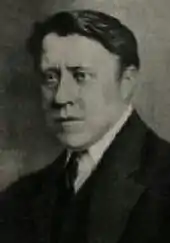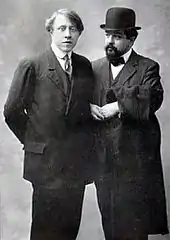André Caplet
André Caplet (23 November 1878 – 22 April 1925) was a French composer and conductor now known primarily through his orchestrations of works by Claude Debussy.


Early life
Caplet was born on a boat sailing between Le Havre (Seine-Maritime) and Honfleur (Calvados), the youngest child of a modest family.
Career
He exhibited an unusual talent and originality during his musical education, and won the Prix de Rome in 1901 ahead of Maurice Ravel. He became a close friend of Claude Debussy, sometimes serving as translator, and he orchestrated part of Debussy's Le Martyre de saint Sébastien.[1][2] He also collaborated with Debussy in the orchestration of La boîte à joujoux. In 1911, Caplet prepared an orchestration of Debussy's Children's Corner, which, along with his orchestration of Clair de lune from the Suite bergamasque is probably the most widely performed and recorded example of his work.
Caplet was a composer in his own right, whose works have been overlooked for the most part in the modern repertoire. Especially interesting is his instrumental use of voices, as in his Septuor à cordes vocales et instrumentales from 1909 and in the oratorio-like Le Miroir de Jésus from 1923, which features "choeur de femmes" in an accompanying role Caplet termed "voix d'accompagnement". He also wrote two works based on the short story The Mask of the Red Death by Edgar Allan Poe: Conte fantastique for harp and string quartet, and an orchestral symphonic study Le Masque de la mort rouge.
Caplet served as conductor of the Boston Opera from 1910 to 1914.
Death
While serving in the military during the First World War, he was gassed, which resulted in the pleurisy that eventually killed him. He died in Neuilly-sur-Seine (Hauts-de-Seine), a suburb of Paris, at the age of 46. The next year the sculptor Jacques Zwobada, a native of Neuilly, was commissioned to create a monument to Caplet. This was one of Zwobada's earliest works after he graduated from the École des Beaux-Arts.[3]
Compositions
Works for voice and piano
- Viens! ... Une flûte invisible, (Hugo), August 1900
- Myrrha, (text by Fernand Beissier) cantata for second round competition of the Prix de Rome, July 1901 - Caplet won first prize, also set by Ravel and other second round contestants. Performed in Le Havre November 1901.[4]
- Green, (Verlaine), 1902
- Il était une fois, (Richepin), January 1903
- Poème de mai (Tu nous souriais), (A. Silvestre), 1902
- Dans la fontaine, (P. Gravollet), 1903
- Papillons, (P. Gravollet), February 1903
- Le Livre rose, (P.J. Pain), 1898–1901
- 1.) Le livre ou je veux lire
- 2.) Premier prix
- 3.) Les pleurs de bébé
- 4.) Le furet du bois, mesdames
- Chanson d'automne, (A. Silvestre), 1900
- Paroles à l'absente, (G. Jean-Aubry), 1908
- 1.) Préludes
- 2.) Ce sable fin et fuyant
- 3.) Angoise
- Les Prières, 1914–1917, (also for harp and string quartet)
- 1.) Oraison dominicale
- 2.) Salutation angélique
- 3.) Symbole des apôtres
- Le vieux coffret, (R. de Gourmont), 1914–1917
- 1.) Songe
- 2.) Berceuse
- 3.) In una selva oscura
- 4.) Forêt
- En regardant ces belles fleurs, (C. d'Orleans), October 1914
- Nuit d'automne, (H. de Regnier), 9 March 1915
- Prière normande, (J. Hebertot), 1916
- Solitude, (J. Ochse), 1915
- Quand reverrai-je, hélas!..., (J. du Bellay), 27 August 1916, (published with harp accompaniment by Lyra)
- La croix douloureuse, (R.P. Lacordaire), for the armed forces
- Détresse!..., (H. Charasson), 9 November 1918
- Trois Fables, (La Fontaine), 1919
- 1.) Le corbeau et le renard
- 2.) La cigale et la fourmi
- 3.) Le loup et l'agneau
- Le Pain quotidien, (15 exercises), 1920
- Cinq Ballades françaises, (P. Fort)
- 1.) Cloche d'aube
- 2.) La ronde
- 3.) Notre chaumière en Yveline
- 4.) Songe d'une nuit d'été
- 5.) L'adieu en barque
- L'hymne à la naissance du matin, (reduction, P. Fort), November 1920
- La cloche felée, (C. Baudelaire), January 1922
- La mort des pauvres, (C. Baudelaire), June 1922
- Le miroir de Jésus, (reduction) ( H. Gheon), Summer 1923
- La part à Dieu, (chanson populaire), 1925
Voice and organ
- Pie Jesu, March 1919
- Panis angelicus, 21 June 1919
- Pater noster, November 1919
- Tu es sacerdos, 27 July 1920
- Les prières, 1914-1917
Voice and flute
- Corbeille de fruits, (R. Tagore), September 1924
- Écoute mon coeur, 19 September 1924
Voice and harp
- Sonnet : "Doux fut le trait", (Ronsard), 8 April 1924, published with Quand reverraije... by Lyra
Harp solo
- Deux Divertissements (1. à la française, 2. à l'espagnole'), 1924, published 1925, Durand
Voice and orchestra
- Myrrha, scène lyrique, (1er Grand Prix de Rome), (F. Beissier), 1901
- Il était une fois, (J. Richepin)
- Paroles a l'absente, (G. Jean-Aubry), 1908
- 1.) Préludes
- 2.) Angoisse
- Le vieux Coffret, (R. de Gourmont)
- La croix douloureuse, (R.P. LaCordaire)
- Détresse!..., (H. Carasson)
- Hymne à la naissance du matin, (P. Fort), November 1920
- Les prières (voice, harp, string quartet) (see under voice and piano)
A cappella chorus
- Messe à trois voix, 1919-1920
- 1.) Kyrie eleison
- 2.) Gloria
- 3.) Sanctus
- 4.) Agnus Dei
- 5.) O Salutaris
- "Inscriptions champêtres, (R. de Gourmont), August 1914
Mixed chorus and orchestra
- Été, (V. Hugo), 1899
- Paques citadines, (C. Spinelli), 1920
Orchestral works
- Suite d'orchestre (sur des mélodies populaires persanes), 1900
- Légende (suite symphonique pour harpe chromatique, saxophone et instruments à cordes), 1905 (precursor to Conte Fantastique)
- Étude symphonique
- Le masque de la mort rouge pour harpe chromatique principale, 1908
- Marche solennelle pour le centenaire de la Villa Medicis, 1903
- Salammbô, (poème symphonique) 1902
- Marche heroïque de la Ve Division, pour musique militaire, 1917
- Epiphanie, fresque musicale pour violoncelle principal et orchestre, 1923
Orchestral transcriptions
- Children's Corner (Debussy)
- Pagodes (Debussy)
- Clair de lune from Suite bergamasque (Debussy)
- Le martyre de Saint Sébastien, Fragments symphoniques (Debussy)
Chamber music
- "Quintette" pour piano, flûte, hautbois, clarinette et basson, 1898
- 1.) Allegro
- 2.) Adagio
- 3.) Scherzo
- 4.) Finale
- "Suite persane" pour 2 flûtes, 2 hautbois, 2 clarinettes, 2 bassons, et 2 cors, 1900, version originale
- 1.) Scharki, (allegretto)
- 2.) Nihavend, (andantino)
- 3.) Iskia Samaisi, (vivo)
- "Septuor", pour quatour a cordes et 3 voix feminines, 1909
- "Sonate" pour piano, voix, violoncelle, 1919
- "Conte fantastique (The Masque of Red Death)" d'après Poe pour harpe à pedales et quatour à cordes, (published 1924)
- "Le miroir de Jésus" pour voix principale, 3 voix accompagnantes, quatour a cordes et harpe, (original version: Été), 1923
- "Sonata da chiesa" pour violon et orgue, 1924
- 1.) Quiet
- 2.) Interieur
- 3.) Alleluia
- ”Impressions d’automne – Elégie” pour alto saxophone, hautbois, 2 clarinettes, basson, harpe, orgue et 2 violoncelles, 1905
Cello and piano
- Élegie, 1903
- Allegresse, 1903
- Épiphanie
- Improvisations
Flute and piano
- Feuillets d'album, 1901
- Rêverie et Petite valse, 1897
- Viens! Une flûte invisible, 1900, voice, flute, piano
Piano, two hands
- Menuet dans le style ancien, 1897
- Deux pièces, 1900
Piano, four hands
- Prelude, 1899
- Do, Re, Mi, Fa, Sol (petites pièces faciles), 1901
- Un tas de petites choses, 1919
Reductions for piano, 4 hands and for 2 pianos, 4 hands or 6 hands
- Images (Debussy)
- 1.) Rondes de Printemps
- 2.) Gigues
- 3.) Ibéria
- La Mer (Debussy)
- Le martyre de Saint Sébastien, voix et piano (Debussy)
- La mer, 2 pianos, 6 mains (Debussy)
Sources
French government publication on Caplet.
References
- Bernac (1978): p. 221
- Orledge (2003)
- Bernard Vasseur, Jacques Zwobada – L'œuvre dessiné (Paris: Éditions Cercle d'Art, 2008)
- Revue belge de musicologie: - Volumes 36 à 38 - Page 166 1982 "On Sunday, November 24 (a matinee concert) a Festival Caplet was held in the Théatre Cirque.... The principal work which was presented was his prize-winning cantata Myrrha."
- Bernac, Pierre. The Interpretation of French Song. New York: Norton, 1978.
- Orledge, Robert: "Caplet, André (Léon)", Grove Music Online ed. L. Macy (Accessed 25 November 2003), http://www.grovemusic.com.
- Thiollet, Jean-Pierre, Sax, Mule & Co, Paris, H & D, 2004 ("André Caplet", pp. 108–109)
External links
- Le martyre de Saint-Sébastien: mystère en cinq actes, music by Debussy, transcribed by Caplet Score from Sibley Music Library Digital Scores Collection
- The Masque of Red Death Score from Sibley Music Library Digital Scores Collection
- ResMusicca.com: André Caplet (in French)
- André-Caplet.fr (in French)
- Musicologie.org: André Caplet (in French)
- Free scores by André Caplet at the International Music Score Library Project (IMSLP)